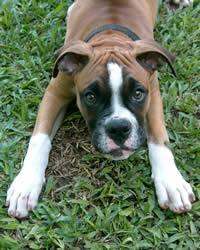Boxer Dogs Breed Information
 |
| ||||||||||||||||||||||||||||||||||||||||||||||||||||||||||||||||||||||||||||||||
Just The Facts
| Do you own this Dog breed?Please tell us about it in the form at the bottom of this page. Need a good Puppy Name?Visit our Boxer dog names page. |
General Description
Boxer dogs are a short haired breed with a shiny and smooth exterior. They are medium sized and have a very powerful jaw. Originally bred as
fighting dogs, Boxers are used more today as guard dogs, in search and rescue work and as police K-9 dogs. Because of their loyal
and lively nature, this breed makes a perfect addition to the family. Although they have a certain pride about them, they are not arrogant.
Origin and History
Boxer dogs originated in Germany, where they were bred as fighting dogs. Their lineage can be traced to two European breeds that no longer exist; the Danziger bullenbaiser and the Brabenter bullenbaiser.
In the 1830s, German hunters began to cross bullenbaisers with mastiff-type breeds which led to the eventual establishment of the Boxer breed in about 1895. Sometime after 1900 Boxer dogs were officially recognized by the AKC, and today this breed is very popular as a family, utility and a show dog.
Temperament
Boxer dogs are highly inquisitive and very devoted. Their playful and loyal nature makes them perfect family and utility dogs. They have a very dignified aura about them and are very good with children and other family pets. They can, however, be aggressive towards unfamiliar dogs, so walking them with a leash is always recommended.
Playful and always full of energy, these dogs crave attention, so be prepared to give plenty of it. They are also fearless dogs and very courageous, making them very good watchdogs.
Care, Grooming, Diet & Exercise
Living Environment – This dog breed does not like to be left alone and they thrive with the constant companionship of their family and
an outdoor yard for play. Be aware that these dogs get bored very easily, can be quite destructive when left alone, and they do not do well in
extreme weather conditions.
Grooming – Since Boxer dogs have a very short coat, it is easy to keep it clean. Grooming twice a week will keep it from shedding around
the house.
Diet & Exercise – These dogs need to be regularly exercised, with brisk and long daily walks being the ideal. To keep them happy and
healthy, they should be indulged in lots of outdoor activities.
Health – Common health problems for Boxer dogs include cancer, colitis, bloat, canine hypothyroidism, respiratory problems and canine heart
disease. Two additional potential health issues to be aware of are arthritis and canine hip dysplasia. The best scenario is to learn about their potential
health issues and their associated symptoms so you can spot them if your dog begins showing symptoms.
Trainability
Boxer dogs are highly intelligent and dog training is relatively easy, provided that you know how to train them. Proper training requires you to be firm and
assertive due to their very strong personality. Boxer dogs can be very headstrong, so training can be a challenge.
As with any dog, these dogs need to know
you are the leader and not the other way around. Early training is very important as it becomes much more difficult with an older dog.
(You can preview and edit on the next page)
Return from Boxer Dogs back to List of Dogs Breeds page